The thirty-nine operas
of Gioachino ROSSINI
(1792-1868)
A conspectus of their
composition and recordings
Part 2
Back in Naples impresario Barbaja wanted
something musically different and scenically
spectacular from his contracted composer
for the re-opening of the rebuilt San
Carlo with its new state of the art
stage facilities. Rossini obliged with
his 22nd opera, Armida.
An included fourteen-minute ballet was
good practice for Rossiniís later Paris
works where a ballet was de rigueur.
In fact Rossini produced his most romantic
opera to date in terms of the opulence
of the music including three extended
love duets. The libretto called for
lavish staging including Armidaís palace
and enchanted garden. There was to be
much comings and disappearances as well
as dances by nymphs, cherubs and dragons.
The lovers Armida and Rinaldo descend
on a cloud that becomes her chariot
and, as she waves her wand, turns into
her castle. Despite the spectacle of
the production, the opera was only moderately
well received. The contemporary critical
opinion was that the music was Ďtoo
Germaní; the implication was that it
was too romantic in the manner of Weber.
The requirements for the staging of
the work restricted its spread although
it found favour in Germany. By the end
of the 1830s it had disappeared, only
re-emerging as a vehicle for Callas
at the 1952 Maggio Musicale in Florence.
Added to the complications and cost
of staging the work is the requirement
of six tenors and much high tessitura,
albeit with the prospect of doubling.
The sole female 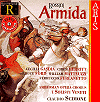 role
is that of Armida. At the premiere Isabella
Colbran sang the role. She was shortly
to become Rossiniís wife, which may
account for the inspiration for some
of his most voluptuous music. The well
recorded bargain-priced Arts performance
(review)
under the idiomatic and scholarly baton
of Claudio Scimone makes the most of
Rossiniís mature music whilst the well
cast soloists make the most of their
bravura opportunities without succumbing
to vocal excess; a highly recommendable
recording.
role
is that of Armida. At the premiere Isabella
Colbran sang the role. She was shortly
to become Rossiniís wife, which may
account for the inspiration for some
of his most voluptuous music. The well
recorded bargain-priced Arts performance
(review)
under the idiomatic and scholarly baton
of Claudio Scimone makes the most of
Rossiniís mature music whilst the well
cast soloists make the most of their
bravura opportunities without succumbing
to vocal excess; a highly recommendable
recording.
Even by Rossiniís standards the time
between the premiere of Armida
in Naples and that of Adelaide
di Borgogna (No. 23) at the
Teatro Argentina in Rome on 27th
December 1817, was short. He is thought
to have composed the opera in less than
three weeks. Aged 25 and with Isabella
Colbran, the diva of Naples his mistress,
he was certainly working and playing
hard. With only slight alteration to
the orchestration he re-used the overture
from La Cambiale di matrimonia (No.
2) but lavished his efforts on the choral
writing. Currently the Fonit Cetra recording
conducted by Alberto Zedda is not available,
but Opera Rara performed and recorded
the work at the 2005 Edinburgh Festival.
Back in Naples, Mosé in
Egito (No. 24) was premiered
on March 5th 1818. Even the
stage facilities at the refurbished
San Carlo could not portray a realistic
parting of the Red Sea. The work was
an immediate success. Mosesís act 3
prayer Díal tuo stellato soglio,
with accompanying chorus, has become
a firm favourite among basses. Although
uneven in some of the solo singing,
the 1981 Philips recording with Ruggero
Raimondi as Moses, conducted by Claudio
Scimone, is a worthy representation
of the work. This recording is of the
1819 revision which is somewhat expanded
from the 1818 premiere. Rossini made
greater revisions when he presented
the work in Paris, in French, in 1827
as Moïse et Pharaon (No.
37, see below). Translated into Italian
this is the basis of an abridged version
of a live Munich performance (Orfeo
C5149921) and an earlier studio recording
conducted by Gardelli on Hungaroton
(HCD 12290-92).
After Mosé Rossiniís only composition
that year was his last one act farse,
Adina (No. 25). This was
a private commission by the son of the
Lisbon Chief of Police. Rossini composed
the work whilst on a visit to his parents
in Bologna in the summer of 1818. It
was not staged until 1826.
On return to his Naples base, Rossini
presented Ricciardo e Zoraide,
(No. 26) on December 3rd.
It was the fifth in the sequence of
nine opera seria he wrote for that city.
Although the libretto has been criticised,
Rossiniís music is innovative and dramatic
with that written for Colbran and the
two Naples tenors, Andrea Nozzari in
the role of Agorante and Giovanni David
as Ricciardo being both florid and dramatic.
The work was well received at its San
Carlo premiere, and later revival, as
well as when seen in  Paris,
Lisbon, Munich and elsewhere. It was
regularly performed until 1846 when
it disappeared from the repertoire until
it was revived at Pesaro in 1990. The
1995 Opera Rara recording (review)
features the tenors Bruce Ford and William
Matteuzzi who portrayed their roles
at Pesaro. The two tenors are particularly
fine in meeting the demands of their
roles as are Nelly Miricioiu as Zoraide
and Della Jones as Zomira. A highly
recommendable recording whose engineering
and conducting matches the quality of
the singing.
Paris,
Lisbon, Munich and elsewhere. It was
regularly performed until 1846 when
it disappeared from the repertoire until
it was revived at Pesaro in 1990. The
1995 Opera Rara recording (review)
features the tenors Bruce Ford and William
Matteuzzi who portrayed their roles
at Pesaro. The two tenors are particularly
fine in meeting the demands of their
roles as are Nelly Miricioiu as Zoraide
and Della Jones as Zomira. A highly
recommendable recording whose engineering
and conducting matches the quality of
the singing.
On March 27th 1819, three
months after Ricciardo, Rossini presented
Ermione (No. 27) at the
San Carlo. The libretto is based on
Racineís great tragedy Andromaque.
The eminent Rossini scholar, Professor
Philip Gossett, considers if Ďone of
the finest works in the history of 19th
century Italian operaí. The Naples audience
were not impressed and it was next heard
in a concert performance in 1977. It
was staged at Pesaro in 1986 with Montserrat
Caballé a formidable heroine.
I personally find the work lacks the
drama and fluidity of Ricciardo.
Nonetheless, I derive much enjoyment
from my 1977 Erato recording (ECD 75336)
conducted by Scimone and with Cecilia
Gasdia as Ermione and featuring the
specialist Rossini tenor duo of Chris
Merritt and William Matteuzzi.
On 24th April 1819, within
a month of the premiere of Ermione,
Rossini presented Eduardo e Cristina
(No 28) at the Teatro San Benedetto,
Venice. In this instance it was not
a question of Rossiniís felicitous capacity
for speedy tuneful composition. Nineteen
of the twenty-six numbers in the opera
were taken from earlier works and a
previous libretto was revised to accommodate
the music! The concoction was a huge
success. The audience at the premiere
encored several numbers and twenty performances
were given in the season. The following
year the work transferred to the La
Fenice, Veniceís premier house. There
were also productions in other cities
although by 1840 it had fallen from
the repertoire. I know of no recordings
of the work.
On his return to Naples in the summer
of 1819 Rossini presented La donna
del lago (No. 29) on 24th
September. It was the first opera to
be based on any of Walter Scottís romantic
works. Although the most famous in our
time is Donizettiís Lucia di Lamermoor,
Scottís popularity as a source of operatic
libretti expanded rapidly after Rossiniís
example. By 1840, a mere 21 years after
La donna del lago, there were
at least 25 Italian operas based on
Scott plus others by German, French
and English composers. Although none
of Scottís works had been published
in Italian at the time, Rossini had
read The Lady of the Lake in
French translation and been inspired
by it. At the premiere on September
24th the opera had a lukewarm
reception that warmed at subsequent
performances. The work remained in the
San Carlo repertory for a further twelve
years and within five years of its composition
it was heard all over Italy and in Dresden,
Munich, Lisbon, Vienna, Barcelona, St.
Petersburg, Paris and London. The Act
2 rondo, Tanti affeti, roused
Naples audiences when sung by Isabella
Colbran. By 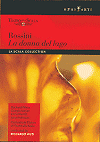 1860
the work was forgotten until its revival
in Florence in 1958. It was performed
and recorded live at Pesaro in 1983.
The recording features Katia Ricciarelli
as Elena, Lucia Valentini Terrani as
Malcolm and Samuel Ramey as Douglas
in a very affecting overall performance
(CBS Masterworks. M2K 39311). The reviewed
mid-price Opus Arte DVD (review)
is of the rather dark 1992 La Scala
staging which lacks any particular Scottish
focus. June Anderson sings with good
firm tone and coloratura. Her tanti
affeti is enthusiastically received.
She also duets well with the creamy
toned Martine Dupuy in the trousers
role of Malcolm. Mutiís conducting draws
the best from what is one of Rossiniís
most inspired and innovative opera seria
scores. There is also an audio recording
from this series of La Scala performances
(Philips 438-211-2).
1860
the work was forgotten until its revival
in Florence in 1958. It was performed
and recorded live at Pesaro in 1983.
The recording features Katia Ricciarelli
as Elena, Lucia Valentini Terrani as
Malcolm and Samuel Ramey as Douglas
in a very affecting overall performance
(CBS Masterworks. M2K 39311). The reviewed
mid-price Opus Arte DVD (review)
is of the rather dark 1992 La Scala
staging which lacks any particular Scottish
focus. June Anderson sings with good
firm tone and coloratura. Her tanti
affeti is enthusiastically received.
She also duets well with the creamy
toned Martine Dupuy in the trousers
role of Malcolm. Mutiís conducting draws
the best from what is one of Rossiniís
most inspired and innovative opera seria
scores. There is also an audio recording
from this series of La Scala performances
(Philips 438-211-2).
Immediately after seeing La donna
del lago staged in Naples, Rossini
went off on one of his frequent absences
to present an opera during the carnival
season at La Scala, Milan. Felice Romani
was on hand to provide the libretto
and Bianca e Falliero
(No. 30) was premiered on December 26th
1819. The work was performed thirty
times during the season and soon spread
throughout Italy and beyond before disappearing
after 1846. It  was
revived at Pesaro in 1986 with Katia
Ricciarelli, Marilyn Horne and Chris
Merritt. The Fonit Cetra recording from
those performances is not currently
available. The Opera Rara recording
(review)
made in November 2000 with Majella Cullagh
as the heroine and Jennifer Larmore
as her lover is an outstanding success
in all respects. The duets between the
two exhibit bravura coloratura singing
of the highest order. The rest of the
cast, conductor and engineering match
this standard.
was
revived at Pesaro in 1986 with Katia
Ricciarelli, Marilyn Horne and Chris
Merritt. The Fonit Cetra recording from
those performances is not currently
available. The Opera Rara recording
(review)
made in November 2000 with Majella Cullagh
as the heroine and Jennifer Larmore
as her lover is an outstanding success
in all respects. The duets between the
two exhibit bravura coloratura singing
of the highest order. The rest of the
cast, conductor and engineering match
this standard.
Another twelve months were to pass
before Rossini presented his next opera,
Maometto II (No. 31).
It was premiered in Naples on December
3rd 1820. This interregnum
between Rossiniís operatic compositions
was connected to personal and political
consideration rather than compositional
inertia or block. Early in the year
he presented an opera by Spontini at
the San Carlo and wrote his Messe
di Gloria. Isabella Colbran, the
lead soprano at the San Carlo, and Rossiniís
mistress, who was to sing Anna Erisso
at the premiere had to return home to
Spain for a period on the death of her
father and to arrange the transfer of
his estate to her. More importantly
civil unrest broke out in Naples with
a group of army officers and priests
leading an uprising against the King
and threatening revolution if he did
not proclaim a constitution. Gunboats
from Britain arrived in the Bay of Naples
and the Austrian army marched in to
provide the King with some backbone.
Rossini is reputed to have served for
a short period in the guardia nazionale
during this period. Maometto II was
received only modestly in Naples. The
recently re-issued Philips 1983 recording
(Decca 475 509 2) conducted by Claudio
Scimone, with Samuel Ramey in the title
role and June Anderson as Anna, reveals
a work of  considerable
dramatic and musical intensity. Rossini
rewrote the work as La Siège
de Corinthe (No. 36) for his Paris
Opera debut in 1826. He also made a
shortened version for performances at
Veniceís San Benedetto theatre in 1822.
This shorter version was performed at
the 2002 Bad Wildbad Festival and recorded
by Naxos (review).
A World Premier Recording, the live
concert is well caught by the engineers,
vibrantly conducted and with the young
singing cast distinguishing themselves.
considerable
dramatic and musical intensity. Rossini
rewrote the work as La Siège
de Corinthe (No. 36) for his Paris
Opera debut in 1826. He also made a
shortened version for performances at
Veniceís San Benedetto theatre in 1822.
This shorter version was performed at
the 2002 Bad Wildbad Festival and recorded
by Naxos (review).
A World Premier Recording, the live
concert is well caught by the engineers,
vibrantly conducted and with the young
singing cast distinguishing themselves.
After the premiere of Maometto,
Rossini went to Rome where he had agreed
to write a new work for the Teatro Apolloís
carnival season. Problems with the libretto
left Rossini with little time and he
enlisted composer colleague Pacini to
assist him by writing three numbers.
Matilda di Shabran (No.
32) was presented on 24th
February 1821. The work had a mixed
reception but quickly spread to other
Italian cities. It reached London in
1823 and New York in 1834. Juan Diego
Florez saved its premiere at Pesaro
in 1996. He jetted in to replace the
indisposed scheduled tenor and subsequent
stardom. He also sang in a new production
at the festival in 2004. It may be that
a CD or DVD of the performance will
be issued. It would be particularly
welcome as a very good all-round cast
also included the delectable Annick
Massis as Matilde. I know of no other
recording.
Back in Naples Rossini found that Barbaja
had arranged for the whole of the company
of the San Carlo to stage a season in
Vienna where Rossini was already the
favourite opera composer. Weberís Der
Freischutz was included in the San
Carlo season alongside six Rossini operas
including Zelmira (No.
33) which had been premiered in Naples
on February 16th 1822. With
Vienna in mind, Rossini took great care
with its composition, but the plot did
not lend itself to success in Naples.
Claudio Scimone praised the score after
conducting it in Venice in 1988, performances
which form the basis of the Erato studio
recording made in London the following
year (2292-45419-2). In the recording
the three tenors are nicely contrasted
and appropriately expressive in the
demanding fioritura. On the distaff
side Cecilia Gasdia in the name part
is well matched by mezzo Bernarda Fink.
This recording is bound to be reissued
where it will find new competition from
Opera Raraís live performance recorded
at the Edinburgh Festival in 2004 (ORC
27) and with Antonio Siragusa managing
the vocal leaps of the David role of
Ilo with ease and welcome tonal beauty.
The down-side is the increasing intrusion
of vociferous applause as the performance
proceeds. The issue includes additional
material Rossini composed for Vienna.
On the way to Vienna Rossini and Colbran
were married. Under the arrangement
Rossini received a dowry equivalent
to about £100,000 at todayís values.
With this money, together with his fees
for the Vienna performances, Rossini
was beginning to have the financial
security he sought and which would relieve
him of the pressures of the hectic compositional
life he had, of necessity, lead previously.
Barbaja, increasingly aware of Rossiniís
asset value was keen to negotiate a
new contract to keep the composer attached
and committed to Naples whilst allowing
him to compose for London and Paris.
Rossini, on the other hand was determined
not to return to Naples and whilst in
Vienna he wrote to the London impresario
Benelli proposing a new opera for that
city involving his wife as lead soprano.
Whilst in Vienna, Rossini was introduced
to Beethoven. The great Austrian composer
encouraged Rossini to write more comic
operas like Il Barbiere di Siviglia.
Rossini for his part was appalled by
Beethovenís living conditions and financial
situation.
The Rossinis left Vienna in July 1822.
It was a measure of Rossiniís status
that he was invited by Prince Metternich
to attend and compose for the Congress
of Verona. During several weeksí stay
he composed five cantatas as well as
attending many receptions. He was introduced
to the Austrian Emperor, the Tsar and
the Duke of Wellington. From Verona
the Rossiniís journeyed to Venice where
the composer had agreed to write an
opera for La Fenice. His fee was an
unprecedented five thousand francs.
During this stay Rossini also presented
the revised version on Maometto II
referred to above.
The new opera for La Fenice was Semiramide
(No. 34) based on Voltaireís tragedy.
The work was well received at its premiere
on February 3rd 1823. It
was performed twenty three times that
season and quickly spread throughout
Italy, Europe and, later, America. After
some years of neglect Semiramide
was revived at La Scala with Joan
Sutherland in the title role. These
performances were the stimulus for Deccaís
recording, which also features Marilyn
Horne in the trousers role of Arsace.
(425 481-2). A new critical edition
was staged at Pesaro in 1992 and is
used in the complete DG recording of
the same year featuring Cheryl Studer
in the name part, Jennifer Larmore,
Samuel Ramey and Frank Lopardo (437
797-2). In Semiramide Rossini
elaborated his stylistic vision. It
was the last opera he composed for the
Italian stage. At age 31 he was ready
for new horizons
After spending time in Bologna in the
summer of 1823 the Rossinis travelled
to London via Paris where the composer
was fêted and began negotiating
about future work. In London he presented
several of his operas although their
success was constrained by Colbranís
declining vocal state. Rossini did,
however, earn considerable remuneration
by singing and playing at musical occasions
organised by English aristocracy. In
Brighton where the Court was in session
he sang duets with the King. The proposed
London opera, although started, was
never completed when Benelli went bankrupt.
The Rossinis returned to Paris, where
the composer was appointed Director
of the Théâtre Italien.
His contract required him to present
productions of his own works, and that
of other composers, as well as writing
new works in French for presentation
at The Opéra (The Théâtre
de líAcadémie Royale de Musique).
The works in French were a little slow
in coming, as Rossini needed to grapple
with the prosody of the language and
re-align his own compositional style
towards that of his new hosts. All this
was to take time and whilst there was
some impatience at the lack of a new
opera from him in French it was recognised
that his revitalisation of the Théâtre
Italien was demanding of his time. First
though was the unavoidable duty of a
work to celebrate the coronation of
Charles X in Reims Cathedral in June
1825. Called Il viaggio à
Reims (a journey to Reims) (No.
35) it was composed to an Italianís
libretto and presented at the Théâtre
Italien on 19th June. It
was hugely successful in three sold-out
performances after which Rossini withdrew
it considering it purely a pièce
díoccasion. The opera plot makes a parody
of the stereotypes of the various nationalities
who become stranded, through lack of
horses, on the way to the Coronation
of Carlos X in Reims. Although Rossini
reused nine of the numbers in Le
Comte Ory (No. 38 below), Il
viaggio became lost until scholarly
research work found missing numbers
in the Santa Cecilia in Rome. By adding
these parts to those found in Paris
and Vienna, Philip Gossett produced
the edition presented at the Pesaro
Festival in 1984. DG engineers combined
the best of the Pesaro performances
to give an outstandingly sung and recorded
issue (414 498-2). That should be a
part of any collection of Rossiniís
operas. There is also available a DVD
of a performance at Barcelonaís Grand
Liceu in March 2003 conducted by Jesus
Lopez-Cobos (TDK DV-OPVAR)
For his first work in French, Rossini
established a tradition later followed
by Donizetti and Verdi of revising an
earlier work to a new libretto. The
first of two such revisions was Le
Siège de Corinthe (No.
36). It was premiered to massive acclaim
at The Opéra on October 9th
1826. This was Rossiniís second revision
of Maometto II. Whilst the first
revision, as noted, reduced the length
of the work, for the Paris performances
Rossini added an overture, several new
numbers and the de rigueur ballet. It
clocked up no fewer than one hundred
performances at The Opéra within
thirteen years. It was quickly seen
in translation throughout the Italian
peninsula as LíAssedio di Corinto.
The Paris staging was lavish with the
final tableau depicting the sacked and
burning Corinth being both viscerally
and visually thrilling and horrifying.
Francis Toye wrote Ďwith this work Grand
Opera was borní. The plot concerning
Greeks and Turks was particularly apposite
in the Paris of the premiere where the
Greek cause found much favour. It needs
another spectacular staging to be caught
on DVD to bring this French version
back into favour. As it is, there is
a worthwhile studio recording conducted
by Thomas Schippers of the Italian translation
in a version prepared for La Scala in
1969 featuring Beverly Sills and Shirley
Verrett (EMI CMS 64335-2).
Rossiniís second work for The Opéra
was Moïse et Pharaon (No.
37). Derived from the Italian Mosé
in Egitto, the revised French language
libretto involved several name changes
and expanded the opera into four acts.
The necessary ballet music in act 3
was taken from Armida. As well
as new music Rossini also drew from
Bianca e Faliero. Moïse
et Pharaon was premiered on
6th March 1827 and was received
with even greater appreciation than
that accorded Le Siège de
Corinthe. An Italian translation
called Mosé e faraone quickly
followed. The newly issued DVD of the
2003 La Scala production conducted by
Muti ( to be reviewed) fills a major
gap in the availability of Rossiniís
works. Although lacking Francophone
singers, and having some idiosyncratic
stage effects, the recording provides
a vivid and well-sung performance of
a work that deserves greater circulation.
A month before the premier of Moïse
et Pharaon, Rossiniís mother died
in Bologna. The composer took her death
badly and after bringing his father
to Paris he increasingly talked of retirement.
By the spring of 1828 the Paris newspapers
were speculating about a possible end
to his career as an opera composer.
In this period he wrote some occasional
music and despite having agreed to write
Guillaume Tell for The Opéra
he first turned his hand to a comic
work, Le Comte Ory (No.
38). For this opera he re-used five
of the nine pieces in Il viaggio
a Reims, and reduced the need for
primo voices. First heard on 20th
August 1838 Le Comte Ory further
consolidated Rossiniís reputation. It
was a favourite work of Vittorio Gui,
music director of the Glyndebourne Festival,
and a recording was made after performances
at the Edinburgh Festival in 1954. This
scintillating performance kept the work
in the public domain and the LP catalogue,
along with Il Barbiere and La
Cenerentola, until the composerís
other works 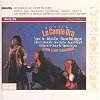 began
to be more widely performed and recorded
from the mid-1970s. In sonic terms it
has largely been superseded by Philipsí
highly enjoyable 1988 recording conducted
by John Eliot Gardiner deriving from
performances at the Lyons Opera (review).
A more recent audio recording from the
Pesaro Festival
began
to be more widely performed and recorded
from the mid-1970s. In sonic terms it
has largely been superseded by Philipsí
highly enjoyable 1988 recording conducted
by John Eliot Gardiner deriving from
performances at the Lyons Opera (review).
A more recent audio recording from the
Pesaro Festival 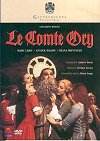 features
Juan Diego Florez. His pinging top notes
and ease in the highest register are
not enough for my ears to overcome the
disadvantages of a live audio performance
and an uneven cast (DG 477 5020). More
welcome has been the arrival of a DVD
of the 1997 Glyndebourne production.
It is a wholly delightful performance
well caught for the medium by nonpareil
video director Brian Large (review).
features
Juan Diego Florez. His pinging top notes
and ease in the highest register are
not enough for my ears to overcome the
disadvantages of a live audio performance
and an uneven cast (DG 477 5020). More
welcome has been the arrival of a DVD
of the 1997 Glyndebourne production.
It is a wholly delightful performance
well caught for the medium by nonpareil
video director Brian Large (review).
In 1828 when Rossini began composing
Guillaume Tell
(No. 39) he was 36 years old and following
the death of Beethoven he was the worldís
best-known composer. It was to be his
last opera despite his living until
his 76th year. As Director
of Parisís Théâtre Italien,
Rossini had a guaranteed annuity for
life and had earned considerable sums
at the 1822 Vienna Festival and during
his visit to London. With good counsel
from banker friends he had enough money
to live in style. Many have speculated
that given his liking for social activities
he saw no reason to continue the strained
and hectic life he had perforce been
leading. There was also the question
of his mental resilience and physical
state. His marriage was not successful
and he was much distressed by his motherís
death. His physical state was affected
by his chronic gonorrhoea exacerbated
by frequent, and futile, stringent treatments
and which certainly lead to depression.
Whilst Rossini had hinted at possible
retirement during the composition of
Guillaume Tell, the work
itself shows no signs of any waning
of musical creativity, or capacity and
concern for detail on his part. It is
by far his longest opera, a complete
performance lasting nearly four hours.
Rossini took excessive care over its
libretto, casting and composition. Sections
at the end of act 2 where the representatives
of the three Cantons assemble and agree
to revolt against the tyranny of Governor
Gesler draw from Rossini some of his
most memorable music in an opera full
of melodic and dramatic felicity. Donizetti
is reputed to have attributed the rest
of Guillaume Tell to Rossini
but act 2 to God!
Because of its length there was an
early propensity to cut out sections
of Guillaume Tell. Within
a year it was presented in three abbreviated
acts and then act 2 only was given as
a curtain-raiser to ballet performances!
The opera was first presented in Italian
translation at Lucca in 1831 and then
at the San Carlo in Naples in 1833.
Commendable audio recordings are available
in both the original French and Italian
translation. The French has Nicolai
Gedda and Caballé under Gardelliís
baton (CMS 769961-2) whilst 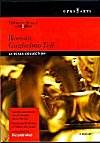 the
Italian version has Pavarotti and Mirella
Freni conducted by Chailly (Decca 417
154-2). Both recordings, on four CDs,
feature a full text and tenors with
good upward extensions well able to
assay the 456 Gs, 93 A flats, 54 B flats,
15 Bs, 19Cs and 2 C sharps required
of the role of Arnold. There is also
a DVD of the 1988 La Scala performance
available (Opus Arte OA LS 3002 D) [review].
The reviewed CD from Orfeo (review),
is of a live performance in French given
at the Vienna State Opera in 1998. Giuseppe
Sabbatiniís tightly focused, but ever
musical and tastefully phrased tenor
meets the demands of the high notes
if not
the
Italian version has Pavarotti and Mirella
Freni conducted by Chailly (Decca 417
154-2). Both recordings, on four CDs,
feature a full text and tenors with
good upward extensions well able to
assay the 456 Gs, 93 A flats, 54 B flats,
15 Bs, 19Cs and 2 C sharps required
of the role of Arnold. There is also
a DVD of the 1988 La Scala performance
available (Opus Arte OA LS 3002 D) [review].
The reviewed CD from Orfeo (review),
is of a live performance in French given
at the Vienna State Opera in 1998. Giuseppe
Sabbatiniís tightly focused, but ever
musical and tastefully phrased tenor
meets the demands of the high notes
if not  quite
having the heft and robust tone the
role ideally requires in its most dramatic
moments. Nancy Gustafson as Mathilde
is less than ideal whilst Thomas Hampson
in the title role sings well and Fabio
Luisi is the outstanding conductor.
All round it is a vibrant performance
but misses around 40 minutes of music
compared with the studio recordings
mentioned. Davis Pountneyís production
was not appreciated by many of the audience
who voice their disapproval from time
to time.
quite
having the heft and robust tone the
role ideally requires in its most dramatic
moments. Nancy Gustafson as Mathilde
is less than ideal whilst Thomas Hampson
in the title role sings well and Fabio
Luisi is the outstanding conductor.
All round it is a vibrant performance
but misses around 40 minutes of music
compared with the studio recordings
mentioned. Davis Pountneyís production
was not appreciated by many of the audience
who voice their disapproval from time
to time.
No collection of Rossiniís operatic
works would be complete without a collection
of overtures from his
operas, all of them full of melodic
musical invention and unexpected felicities.
Ola Rudnerís ABC Classics CD
(review) has nine whilst a Double Decca
from Chailly manages fourteen (443 850-2).
A Philips Duo CD issue of Rossiniís
ballet music from Le Siège
de Corinthe, Otello, Moïse
and Guillaume Tell, along
with some of Donizettiís ballet music
composed for his Paris works and conducted
by Antonio De Almeida is worth hearing
(442 533-2).
Also essential are vocal recitals from
some of the leading Rossini singers.
The dramatic 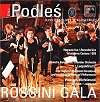 low
mezzo Ewa Podles features six arias
recorded live at a concert in her native
Poland in 1998 (DUX 0124) [review].
She also sings arias from
seven of his operas including Semiramide,
Maometto II and La donna del
lago in a highly enjoyable 1995
studio recording (Naxos 8.553543). Also
commendable is fellow mezzo and great
exponent of Rossini, Marilyn Horne.
She can be heard on an excellent Decca
recording titled Heroes and
low
mezzo Ewa Podles features six arias
recorded live at a concert in her native
Poland in 1998 (DUX 0124) [review].
She also sings arias from
seven of his operas including Semiramide,
Maometto II and La donna del
lago in a highly enjoyable 1995
studio recording (Naxos 8.553543). Also
commendable is fellow mezzo and great
exponent of Rossini, Marilyn Horne.
She can be heard on an excellent Decca
recording titled Heroes and  Heroines
(476 7089) and which features arias
from six operas including extensive
excerpts from the rarely heard Líassedio
di Corinto. She also features on
a CD of alternative arias that Rossini
wrote for specific singers and productions
after the premiere [review].
Heroines
(476 7089) and which features arias
from six operas including extensive
excerpts from the rarely heard Líassedio
di Corinto. She also features on
a CD of alternative arias that Rossini
wrote for specific singers and productions
after the premiere [review].
The recent tenore di grazia favourite,
Juan Diego Florez, sings in some duets
with Vesselina Kasarova on her all-Rossini
CD (RCA 74321 57131 2)  that
made the charts in 1999 as did his 2002
solo disc of tenor arias from eight
of the composerís works (Decca 470 024
-2). The three Rossini items involving
Kasarova and Florez from the RCA issue
are repeated on a recommendable disc
of duets constructed round the Bulgarian
mezzoís previous recordings. (RCA 82876
52929 2) [review].
On the remaining tracks she is joined
by Eva Mei and Ramon Vargas in excerpts
from the 1995 recording of Tancredi
(RCA 09026 68349 2) whilst the duet
from Maometto II comes from an RCA disc
called Between Friends and focuses on
Vargas (RCA 82876 54243 2) (review)
Samuel Ramey, with his flexible sonorous
bass was a great favourite at Pesaro,
and on disc, in a number of Rossini
roles. His recital disc on Teldec is
well worth searching out (9031-73242-2).
that
made the charts in 1999 as did his 2002
solo disc of tenor arias from eight
of the composerís works (Decca 470 024
-2). The three Rossini items involving
Kasarova and Florez from the RCA issue
are repeated on a recommendable disc
of duets constructed round the Bulgarian
mezzoís previous recordings. (RCA 82876
52929 2) [review].
On the remaining tracks she is joined
by Eva Mei and Ramon Vargas in excerpts
from the 1995 recording of Tancredi
(RCA 09026 68349 2) whilst the duet
from Maometto II comes from an RCA disc
called Between Friends and focuses on
Vargas (RCA 82876 54243 2) (review)
Samuel Ramey, with his flexible sonorous
bass was a great favourite at Pesaro,
and on disc, in a number of Rossini
roles. His recital disc on Teldec is
well worth searching out (9031-73242-2).
In preparing this conspectus I have
been indebted to the following sources:-
- Gioachino Rossini. Philip
Gossett in The New Grove, Masters
of Italian Opera, pp 1-90. Edited
Stanley Sadie. Macmillan, London,
1983
- Rossini. Charles Osborne.
Master Musicians Series. J M Dent.
1987
- The Bel Canto Operas. Charles
Osborne. Methuen 1994. pp 3-136 and
Selective Discography pp 356-359
- Innumerable CD booklets and sleeve-notes,
often by Philip Gossett who, for the
last thirty years or so, has been
widely accepted as the foremost Rossini
scholar. He, together with Alberto
Zedda, conductor and fellow scholar,
did much to establish the Rossini
Foundation and Festival at Pesaro.
Robert J Farr
16 November 2005

